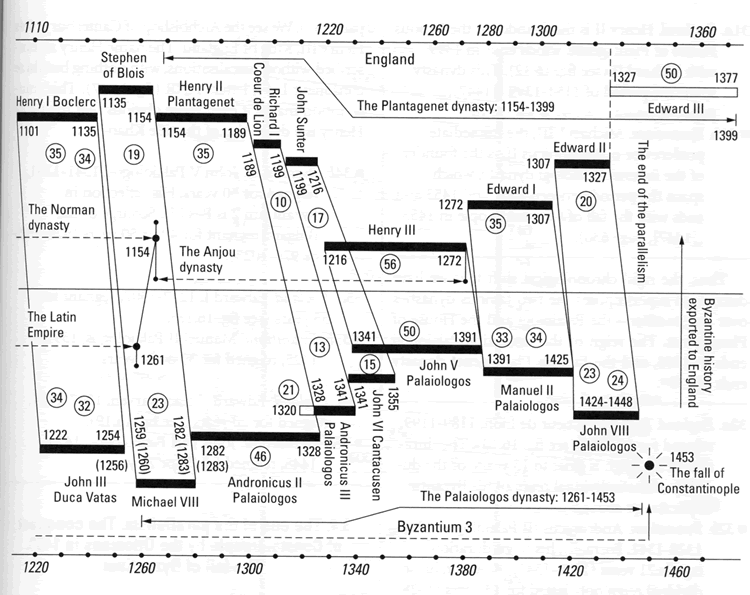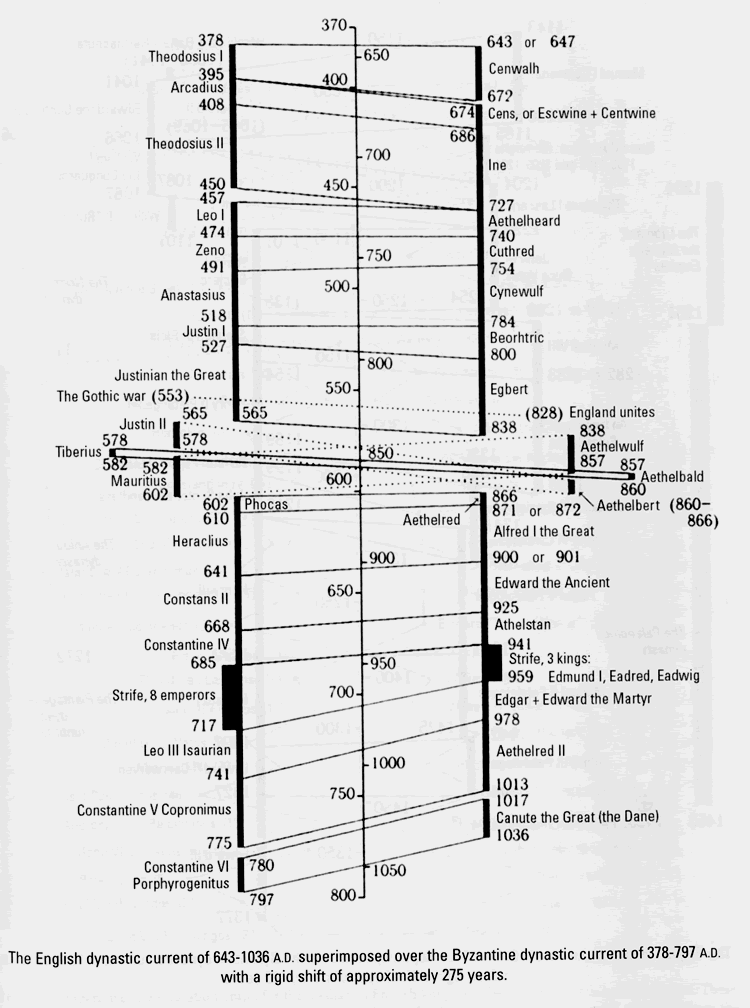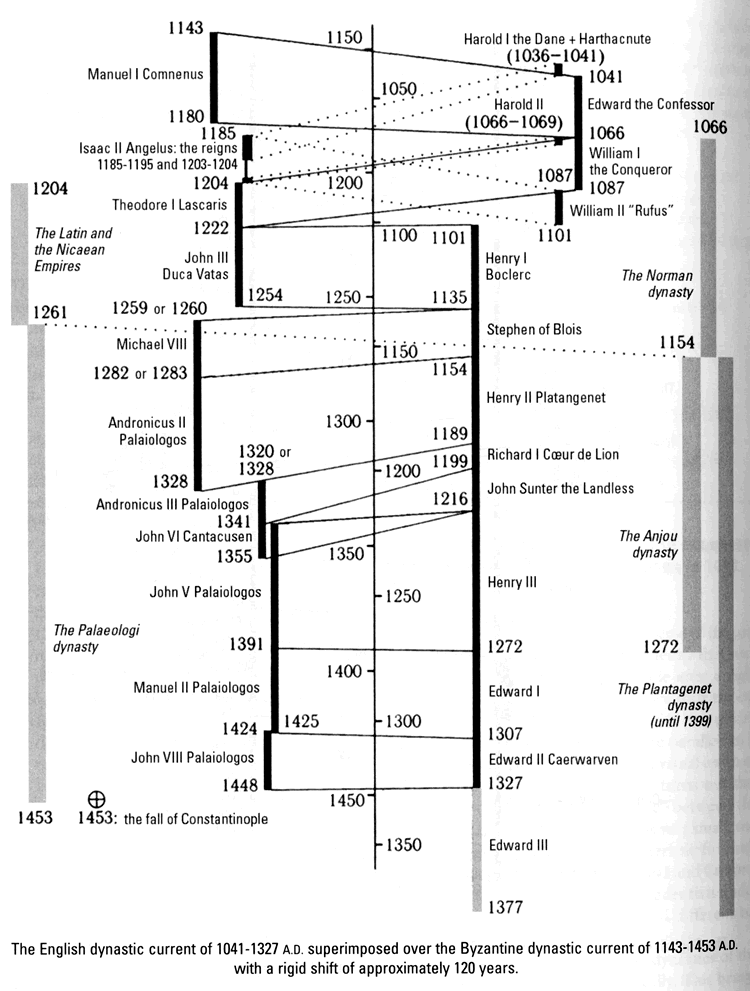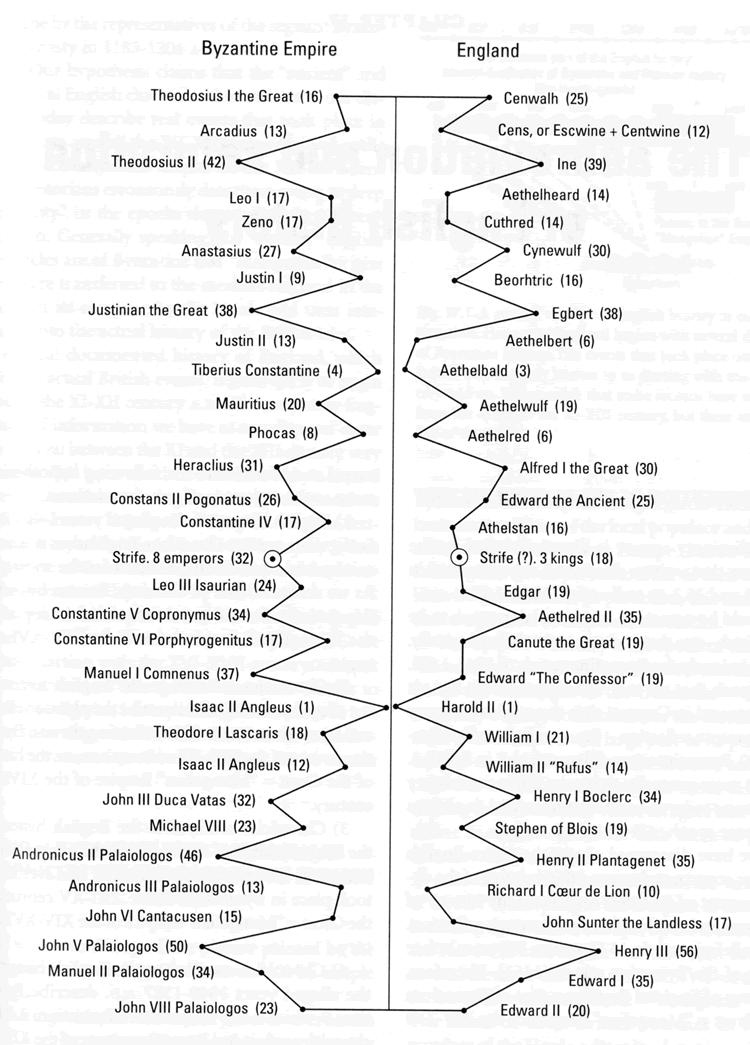3. PARALLELS BETWEEN ENGLISH AND BYZANTINE-ROMAN HISTORY
3.3. Some details of dynastic parallelism ("parallelism table").
3.3.1. English history of 640-830 A.D. and Byzantine history of 378-553 A.D. Rigid 275-year shift.
We used J.Blair's Tables [2] as the first main source of chronological information and Anglo-Saxon Chronicle as the second one. Below we use an abbreviation ASC for Anglo-Saxon Chronicle. Note that sometimes different chronological tables contain a slightly different data, but these differences do not influence the parallelism which we are going to present here.
English history Byzantine history
_________________________________________________________________
English history of 640-830. Byzantine history of 378-553.
Wessex kings - one of the six Byzantine emperors dynasty
kingdoms in England of 400-830. starting from the foundation of
This dynastic stream is a part New Rome = Constantinople.
of the dense sequence of kings This dynastic stream is a part
whose reigns cover the time of the dense sequence of kings
axis with high multiplicity. whose reigns cover the time
See Figs.2a, 2b, 3. axis with high multiplicity.
This period of Byzantine history
is denoted as Byzantine-0 on
See Figs.2a, 2b, 3.
__________________________________________________________________
Commentary. Durations of reigns are shown in brackets
(rounded off to whole years). In the left column the whole list of
English kings is presented. In the right column almost all Byzantine emperors appear. Only absent are names of some emperors with very short reign and co-emperors of those ones who are presented here. Note that all English kings (with only few exceptions of very short reigns) are included in this parallelism.
__________________________________________________________________
1. Cenwalch 643-672 king of 1. Theodosius I The Great
Wessex and 643-647 as the king 378 or 379 - 395 (16)
of Sussex. He ruled 29 or 25
years, if we consider only his
rule in Wessex (after 647 A.D.)
------------------------------------------------------------------
Queen Seaxburh 672-674 (2), ?
wife of K.Cenwel. Short rule
------------------------------------------------------------------
2. Cens 674-686 (12) according 2. Arcadius 395-408 (13)
to Blair. In Anglo-Saxon
Chronicle we see here two kings:
Escwine + Centwine (9 years in
total)
------------------------------------------------------------------
Caedwalla 686-688 (2). ?
Short rule
------------------------------------------------------------------
3. Ine 686-727 (39) according 3. Theodosius II 408-450 (42)
to Blair and (37) according to
Anglo-Saxon Chronicle (= ASC)
------------------------------------------------------------------
4. Aethelheard 727-740 (13), 4. Leo I 457-474 (17)
and (14) according to ASC
------------------------------------------------------------------
5. Cuthread 740-754 (14) accor- 5. Zeno 474-491 (17)
ding to Blair and (17) in ASC (he ruled two times)
------------------------------------------------------------------
Sigeberht 754 (1). Short rule ?
------------------------------------------------------------------
6. Cynewulf 754-784 (30) accor- 6. Anastasius
ding to Blair and (31) in ASC 491-518 (27)
------------------------------------------------------------------
7. Beorhtric 784-800 (16) 7. Justin I 518-527 (9)
------------------------------------------------------------------
8. Egbert 800-838 (38). In 828 8. Justinian I The Great. In
A.D.(i.e., at the 28th year of 553 A.D.(i.e. at the 26th year
his rule) he consolidated all of his rule) he defeated the
six kingdoms into one - Anglia. Goths (this is well-known Gothic
The last 10 years he ruled as war) and became unique emperor
the king of Anglia. He is consi- in Roman-Byzantine empire. He
dered as distinguished king in ruled during his last 12 years
English history. without any corulers. Well-known
emperor in Byzantine history/
________________________________________________________________
3.3.2. English history of 830-1040 and
Byzantine history of 553-830. Rigid 275-year shift.
__________________________________________________________________
English epoch of 830-1040. Byzantine epoch of 553-830.
Anglia after consolidation into Is denoted as "Byzantine
one kingdom (see Blair [6]). empire-1" in the Fig.1b .
__________________________________________________________________
9. Aethelberht 860-866 (6) 9. Justin II 565-578 (13)
-----------------------------------------------------------------
10. Aethelbald 10. Tiberius Constantinus
857-860 (3) 578-582 (4)
------------------------------------------------------------------
11. Aethelwulf 838-857 (19) 11. Maurice 582-602 (20)
------------------------------------------------------------------
12. Aethelred 866-872 (6) 12. Phocas 602-610 (8)
------------------------------------------------------------------
Here the old English chroniclers transposed two kings, namely -
the kings Aethelwulf (see No.11) and Aethelberht (see No.9) were
placed in another order (their Byzantine duplicates are Justin II
and Maurice). This confusion has a simple explanation: all four
English kings of this period have very similar names beginning
from "Aethel".
------------------------------------------------------------------
13. Alfred The Great 872-900 (28) 13. Heraclius
according to Blair and 871-901 610-641 (31)
(30) according to Bemont and
Monod ([7],p.340)
------------------------------------------------------------------
14. Edward the Elder 14. Constans II
900-925 (25) Pogonatus 641-668 (26)
------------------------------------------------------------------
15. Athelstan 925-941 (16). 15. Constantine IV
It is supposed today that he was 668-685 (17)
the first who took the name king
of Anglia ([7],p.340)
------------------------------------------------------------------
16. Confusion: the war with 16. Well-known confusion in
Northumbria. The Anglo-Saxon Byzantine history in the end of
Chronicle mentions about 7th century - beginning of 8th
three main kings of this period: century. Here there are several
Edmund I 941-948 (7), emperors with a short rules:
Eadred 948-955 (7), Leontius II 695-698
Eadwig 955-959 (4). All these or 694-697, Tiberius III 697-704
kings ruled relatively short or 698-705, Justinian II 705-711,
period Philippicus Bardanes 711-713,
Anastasius II 713-715 or 716,
Theodosius III 715 or 716-717
------------------------------------------------------------------
Thus, both confusion epochs (English and Byzantine) are matched
under the rigid chronological shift. We did not discuss here the
details because of mess structure of the chronicles of this time
period
------------------------------------------------------------------
17. Edgar 959-975 (16)+ Edward 17. Leo III Isaurian or
"The Martyr" 975-978 (3), and the Syrian 717-741 (24)
totally (after summation) they
give 19 years. Their names are
similar and consequently their
union is natural
------------------------------------------------------------------
18. Aethelred II "The Unready" 18. Constantine V Copronimus
978-1013 (35) 741-775 (34)
------------------------------------------------------------------
19. Cnut The Great Danish 19. Constantine VI Porphyrogenitus
1017-1036 (19). His death 780-797 (17). Let us note that
indicates the disintegration now we are in the end of historical
of Danish empire. Thus, this epoch which was marked out in
epoch is finished by the well- [1] and [24] as Byzantine empire-1
known event in the history of (527-840). Thus, in this column
Anglia. Let us note that this of our table we came to some
fragment of English history is important turning-point in
matched with Byzantine epoch Byzantine history
under 210 (or 275)-year shift
(approximately)
_________________________________________________________________
The old English chronicles placed in the end of this epoch
(in history of Anglia) two "short" kings:
Harold I Danish (1036-1039, ruled 3 years) and
Harthacnut (1039-1041, ruled 2 years).
We did not find the Byzantine duplicate-original for Harthacnut,
but the original-duplicate for Harold I will be demonstrated below
__________________________________________________________________
We continue the motion along English history in the left
column of the table. The parallel with Byzantine history will
continue (in the right column). But this parallel becomes more
clear and evident if we take the next epoch "Byzantine empire-3"
(1143-1453) instead of the epoch "Byzantine empire-2" (Fig.1b ). As
we explained before, these two epochs of Byzantine history are
parallel, i.e. they are duplicates (of course, not identical).
Consequently, we will list in the right column of the table the
emperors from "Byzantine empire-3" and also will indicate here
their duplicates from "Byzantine empire-2". And we will see that
the parallelism between English and Byzantine history will
continue until the fall of Constantinople in 1453.
__________________________________________________________________
3.3.3. English history of 1040-1327 and
Byzantine history of 1143-1453. Rigid 120-year shift.
__________________________________________________________________
English epoch of 1040-1327 Byzantine epoch of 1143-1453.
Is marked as "Byzantine empire-3"
in the Fig.1b . It is the original
for "Byzantine empire-2"
__________________________________________________________________
20. Edward "The Confessor" 20. Manuel I Comnenus
1041-1066 (25) 1143-1180 (37)
------------------------------------------------------------------
The death of Edward "The Confes- After the death of Manuel I the
sor" indicates the beginning of hard time for Byzantine empire
Norman invasion. It is possible, began and the turning-point is
that English chronicles mean the well-known crusade and the
here in reality "Roman invasion" conquest of Constantinople in
because there is the parallel 1204. It is supposed today that
between some periods of Roman Italian Rome organized the
history and Norman history invasion in Byzantine empire
(see [1],[24])
------------------------------------------------------------------
The commentary to the dynastic stream of English history.
After the death of Edward "The Confessor" a new king Harold II
"Godwinson" took the throne. He ruled only 1 year and was killed
in 1066 in the battle near Hastings. From the other hand it is
known ([7],p.343) that in reality he got a great political power
in 1054 when Edward was alive. But the English chronicles placed
just before the rule of Edward "The Confessor" one more "short"
(i.e. with a short rule) Harold, namely Harold I "Harefoot"
(1036-1039) who ruled only 3 years. It is possible that this
Harold I is simply the reflection of Harold II
------------------------------------------------------------------
21. "Doubled Harold", i.e. 21. Isaac II Angelus 1185-1195,
Harold I Danish (1036-1039) and then he lost the power and
then Harold II (1066 year). appeared on Byzantine throne
Harold II ruled only 9 months. again in 1203 (second time). He
It is clear that this "doubled ruled no more than 1 year and
Harold" is the reflection of finally lost the power in 1204,
Byzantine"doubled Isaac Angelus", after the conquest of Constanti-
who ruled two times. His second nople by crusaders. Thus, his
rule was short: less than 1 year second rule was no more than 1
year
------------------------------------------------------------------
Norman conquest of Anglia. The The conquest of Byzantine empire
famous battle near Hastings in by crusaders. Famous fourth
1066 crusade 1199-1204
------------------------------------------------------------------
We will speak later and more detailed about the parallel between
these events
------------------------------------------------------------------
22. William I of Normandy 22. Theodore I Lascaris
(Bastard) The Conqueror 1066- 1204-1222 (18). In 1204 a new
-1087 (21). His rule starts the Nicaean empire starts on the
new Norman dynasty in Anglia territory of Byzantine empire. The
reflection of Theodore in Byzantine
empire-2 is Basil I the Macedonian
867-887 (19)
------------------------------------------------------------------
23. William II "Rufus" 1087-1101 23. Possibly, there is some mess
(14). Thus, here we have 14 in the chronicles when they
describe
years and in the right column the Norman dynasty and Nicaean
we have 11 or 12 years. We see empire. The first conjecture:
here some confusion in the the original preimage for William II
chronicles because in the right is lost. Second conjecture: this is
column Isaac II Angelus ruled again Isaac II Angelus. But in this
twice case the chronicle took the whole
his rule: 1185-1195 and then 1203-
-1204, i.e. totally 11 or 12 years.
------------------------------------------------------------------
24. Henry I 1101-1135 24. John III Vatatzes
(34 or 35 years) 1222-1254 or 1256 (32). His
reflection in Byzantine empire-2
is Leo VI "The Philosopher"
886-912 (26)
------------------------------------------------------------------
25. Stephen of Blois 1135-1154 25. Michael VIII 1259 or 1260
(19). King Stephen finishes the until 1282 or 1283 (23). His
Norman dynasty in Anglia ([7],p. reflection in Byzantine empire-2
357). The next king Henry II is Romanus I 919-945 (26).
starts a new Anjou dynasty in Michael VIII starts a new
Anglia Palaeologus dynasty which lasts
from 1261 until 1453
------------------------------------------------------------------
Thus the rigid chronological shift matches English Norman dynasty with Byzantine dynasty of Angelus and then matches the next Anjou dynasty with Byzantine dynasty of Palaeologus.
------------------------------------------------------------------
26. Henry II Plantagenet 26. Andronicus II Palaeologus
1154-1189 (35). Note that both 1282 or 1283 - 1328 (46). If
terms Plantagenet and calculated from 1283 to 1320 -
Porphyrogenetus have the same the moment when his co-ruler
meaning: "one who was born in Andronicus III began to reign
a shirt". This term has well- then duration of Andronicus II
known meaning - see commentary reign is 37 years. He was
below reflected as Constantine VII
910 or 912 - 959 (47),(49)
in Byzantine empire-2.
---------------------------------------------------------------
Commentary.
Term (name) "Porphyrogenetus" = "Porphyro" + "Genitus" could be
interpreted as "one, who was born in porphyr". It says about
birth in a "royal attributes", maybe "royal clothes", "royal
shirt". It suggests a rare case from medical practice when a baby
is born "in a shirt", i.e. still in placenta (placenta sounds
similar to "planta" - part of "Plantagenet"). In old times such
cases were considered as a sign of outstanding future for the
baby (good or bad one). We see in English version (left column) a
name Plantagenet, i.e. Planta + Genet. It means exactly "birth in
a planta, in a cover" - the same as "birth in a shirt"
------------------------------------------------------------------
27. Henry II established a known 27. Michael VIII. He was just
dynasty of Plantagenets (House of before Andronicus II. He
Plantagenets) in English established a known dynasty of
history. This dynasty was Palaeologus in the history of
finished in 1329 with Richard Byzantine. This dynasty covers
II. So, this dynasty covers time time interval 1261-1453 (up to
interval 1154-1399 ([27], p.346). the siege of Constantinople)
([27], p.636).
------------------------------------------------------------------
So, the chronological shift which we discovered puts together two
dynasties: Palaeologus' and Plantagenets. Dynasty of Palaeologus'
is finished in 1453 and reflecting them Plantagenets continue up
to 1399.
------------------------------------------------------------------
28. Richard I Coeur de Lion 28. Andronicus III Palaeologus
1189-1199 (10). Duration of 1320-1328-1341. Formally his
his reign is 10 years which reign lasts 21 years (1320-1341),
is close to 13 years - duration but his reign as unique emperor
of reign of his analog (without corulers) was only for
(original) in Byzantine 13 years (1328-1341). In 1328
empire finished the reign of his coruler
- emperor Andronicus II.
------------------------------------------------------------------
29.John Santer 1199-1216 (17) 29. John VI Cantacuzenus
1341 or 1347 - 1355 (15)
------------------------------------------------------------------
30. Henry III 1216-1272 (56). 30. John V Palaeologus 1341-1391
Henry III was the last king in (50). His has a reflection in
Anjou dynasty in England. Byzantine empire-2: Basil II
Dynasty of Palaeologus in Bulgaroktonos (975 or 976 -
Byzantine empire (right column) 1025). Basil II Bulgaroktonos'
is not finished at this point reign was for 49 or 50 years.
but it is near to the end
------------------------------------------------------------------
31. Edward I 1272-1307 (35) 31. Manuel II Palaeologus
1391-1425 (33 or 34).
------------------------------------------------------------------
32. Edward II Caervarven 32. John VIII Palaeologus
1307-1327 (20) 1424-1448 (23 or 24).
------------------------------------------------------------------
End of parallelism. In 1453 Constantinople was seized
by Turks and Byzantine Empire
changed to Turkey.
___________________________________________________________________
Fig.4a, Fig.4b, Fig.4c illustrate this parallelism. It is important that durations of reign fit each other so well in the case when the same chronological shift was applied to all reigns. All dynasty was shifted as a whole, it's internal time was unchanged.

Fig.4b

Fig.4c

Fig.5a, Fig.5b, Fig.5c show the same parallelism in a different form which is designed for visual comparison of durations of reign in both dynasties. For quantitative comparison we used numerical characteristic of a distance between two arbitrary dynasties, which was introduced in [1],[24]. It appears that this "distance" drops into a range of values which are normal only for strongly dependent dynasties (details about this numerical characteristic one can find in [1],[24]). Recall that two dynasties are called as dependent ones if they both reflect the same real dynasty.

Fig.5b

Fig.5c

Dependence of these two dynasties (we mean statistical dependence of reign durations) is the main result of this paper. It is in fact a formal result and we might finish on it. But many not formal questions follow after this result is claimed. Main of them is: what real events lay under both of these two dynasties? What was the real history?